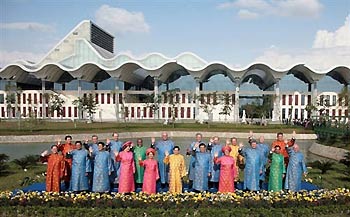
Leaders from the APEC member economies dress up Vietnamese traditional tunics (ao dai) for a group photo at the closing ceremony of the two-day 14th APEC Economic Leaders’ Meeting yesterday in Hanoi, Vietnam. -CHINANEWS.com.cn
Chinese President Hu Jintao was in blue, host Vietnamese President Nguyen Minh Triet in yellow, Singapore Prime Minister Lee Hsien Loong in red and the Philippines’ Gloria Macapagal Arroyo in pink. All have shined when dressing up Vietnamese traditional tunics (ao dai) for a group photo at the closing ceremony of the two-day 14th APEC Economic Leaders’ Meeting yesterday.
At the tree-covered Van Tue Island in the new ship-shaped National Convention Center’s campus, most of leaders from the 21 member economies of the Asia-Pacific Economic Cooperation (APEC) in elegant silk “ao dai” with golden lotus flower patterns lined up for the photo, which is considered symbol of the solidarity in the Asia-Pacific region.
The leaders slipped the “ao dai”, designed in five bright colors and decorated with lotus flowers — a Vietnamese traditional symbol of nobleness and purity over their businesses suits, giving a look of prestige and dignity. The APEC “ao dai” come in blue, red, yellow and green for male leaders, while women ones had a choice of pink.
Leaders of South Korea and Singapore looked relaxed in red, others from China, the United States, Russia and Japan went blue, and those from Vietnam and Thailand in yellow, and Brunei and Papua New Guinea in green. Meanwhile, three female leaders from the Philippines, News Zealand and Chile got charmer in pink dress and velvet turbans.
It is a tradition for leaders to wear costumes bearing the symbol of host members of APEC for the closing group photo at annual meetings. Last year, they wore silk overcoat, “durumagi”, in South Korea. Previously, they donned short-sleeved silk shirts in Thailand, silk jackets in China, and batik shirts in Indonesia.
To dress leaders at the meeting this year, host Vietnam chose the “ao dai” motif designed by Minh Hanh, one of the country’s top designers and vice director of the Vietnam Fashion Design Institute (FADIN).
“Ao dai”, fitted long robe with two-side slits up to the waist being worn over silk white trousers, is considered a symbol of Vietnamese intangible culture, helping to flatter local women’s beauty, figure and charm. The garments are now popular for local women, mostly in special occasions such as weddings, ceremonies and festivals.
Hanh and her workers spent over eight months on the costume, from creating high-quality silk for the garments to drawing up 32 different patterns to woven into the cloth.
“Over the past eight months, we have had worked all day and night for the costumes, and they have experienced close scrutiny. When the design was officially chosen, government officials, led by former Deputy Prime Minister Vu Khoan, closely scrutinized them twice. And, around a week ago, State President Nguyen Minh Triet made the final scrutiny,” she said.
“Finally, the lotus design was chosen, as lotus flowers symbolize the beauty and culture of Vietnamese people,” she said, adding that the lotus flower motifs were lively woven in the three-dimension technique to create a special damask silk.
The local Toan Thinh Silk Company had to spend more than five months producing the delicate cloth, she said, adding that the silk selected for the leader’s costumes has to be stiffer than common ones, as they are worn over their suits.
To ensure the honored guests to satisfy with “ao dai”, the FADIN had to send them the drawings of “ao dai” and its requests for their fashion parameters, and present five colors of the costume for their choice.
“I believe that the costumes will satisfy the leaders. Some elder people told me that, in the evening of Nov. 19, billions of people in the world will see the traditional costume wearing etiquette of APEC leaders on TV, and they will partly understand Vietnam’s soul. So, I’m very nervous,” Hanh was recently quoted assaying by local newspaper Youth.
Now, Hanh’s worries must have vanished without trace, since the leaders’ appearance in her elaborate “ao dai” design has not only showed off Vietnam’s traditional culture, but also promoted the country’s image to the Asia-Pacific region and the world at large.
Xinhua News


No comments:
Post a Comment